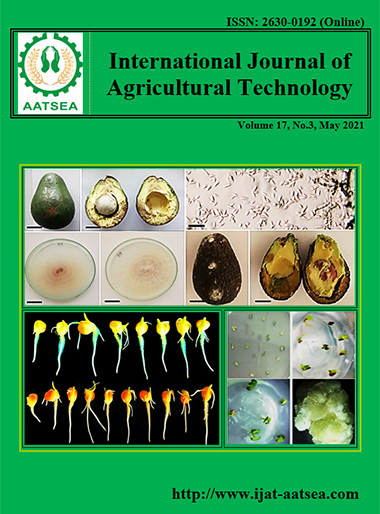Effects of diet additive supplements on the performance and cost of grower-finisher production: A case study in Nakhon Sawan Province, Thailand
Main Article Content
Abstract
The results showed that 0.5% phytase enzyme supplementation did not affect the production performance significantly (P>0.05) resulted to the lowest cholesterol, triglyceride, Economic Loss Index values and the best Product Index value. For experiment 2, the effect of the level of probiotic supplementation with Bacillus sp. on the performance and cost of small and medium-sized grower-finisher pigs were used 3 small crossbred breeds of pigs with 36 fattening periods. The different pigs as in the first experiment revealed their initial average weight was 58 kilograms. The results showed that 1.0% supplementation with probiotics did not significantly affect the production performance (P>0.05) to produce pork with the greatest tenderness and juiciness, product index, economic loss index, and saleable head return. In addition, the return of investment was significantly better for the 1% supplementation group than both in the control group and the 0.5% supplementation group (P <0.05)
Article Details

This work is licensed under a Creative Commons Attribution-NonCommercial-NoDerivatives 4.0 International License.
References
AOAC (1995). Official method of analysis of association of official analysis chemists.16thed. Washington D.C. ssociation Official Analysis Chemists.
Balasingham, K., Valli, C., Radhakrishnan, L. and Balasuramanyam, D. (2017). Probiotic characterization of lactic acid bacteria isolated from swine intestine. Veterinary World, 10:825-829.
Cromwell, G., Coffey. R., Monegue, H. and Randolph, J. (1995). Efficacy of low-activity microbial phytase in improving the bioavailability of phosphorus in corn-soybean meal diets for pigs. Journal of Animal Science, 73:449-456.
Defa, L. X., Che, Y., Wang, S., Qiao, H., Cao, W. and Thacker, P. (1999). The effect of calcium level on microbial phytase activity and nutrient balance in swine. Journal of Animal Science, 12:197-202.
Dowarah, R., Verma, A., Agarwal, N., Patel, B. and Singh, P. (2017). Effect of swine based probiotic on performance, diarrhoea scores, intestinal microbiota and gut health of grower-finisher crossbred pigs. Livestock Science, 195:74-75.
Department of Livestock Development (2017). Strategy department of livestock development 2018 - 2022. Department of Livestock Development, Ministry of Agriculture and Cooperatives.
Gaggia, F., Mattarelli, P. and Biavati, B. (2010). Probiotics and prebiotics in animal feeding for safe feed production. International Journal of Food Microbiology, 141:515-528.
Hou, C., Zeng, X., Yang, F., Liu, H. and Qiao, S. (2015). Study and use of the probiotic actobacillus reuteri in pigs: a review. Journal of Animal Science and Biotechnology, 6:14.
Kitja, U., Thawatchai, S., Worawit, W. and Priyaphan, U. (1994). Disease control and prevention important in Thailand. Faculty of Veterinary Science. Bangkok.
National Research Council (1998). Nutrient requirements of swine. 10th Edi. National academy press, Washington, D.C.
Parichat, S. (2014). Reduction of RIPIN inhibitors for silage fermentation by lactic acid bacteria. (Master Thesis). Kasetsart University, Thailand.
Sanchai, C. (2010). Meat technology. Department of Animal Science and Aquaculture, Faculty of Agriculture, Agriculture Chiang Mai University.
Somkid, D. and Arunee, K. (2013). Separation and selection of microorganisms that produce lactic acid directly from starch to reduce the cost of manufacture of bioplastics. Research report. Maejo University. Chiang Mai.
SAS (1985). SAS/STAT guide for persornal computers, Version 6 ed. North Carolina, USA: SAS Institute Inc.
Suekrit, S. (2018). Probiotics used in livestock. King Mongkut's agriculture Journal, 36:152-156.
Thepsapsorn, S. and Woranuch, P. (2012). Sorting of lactic acid bacteria in probiotics the growth of pathogenic bacteria in the digestive system. (Research Project). Buriram Rajabhat University. Buri Ram.
Uthai, K. (1994). Modern pig feeding and feeding. Books for industrial pig production. Book 1. National Pig Swine Research and Training Center, Kasetsart University, pp.115-126.
Wandee, S., Thongchai, C. and Thawee, P. (2011). The role of probiotics in the swine industry. Faculty of Veterinary Science, Chulalongkorn University. Bangkok.
Yi, Z., Kornegay, E., Ravindran, V., Lindemann, M. and Wilson, J. H. (1996). Effectiveness of natuphos phytase in improving the bioavailability of phosphorus and other nutrients in soybean meal-based semi purified diets for young pigs. Journal of Animal Science, 74:1601-1611.


